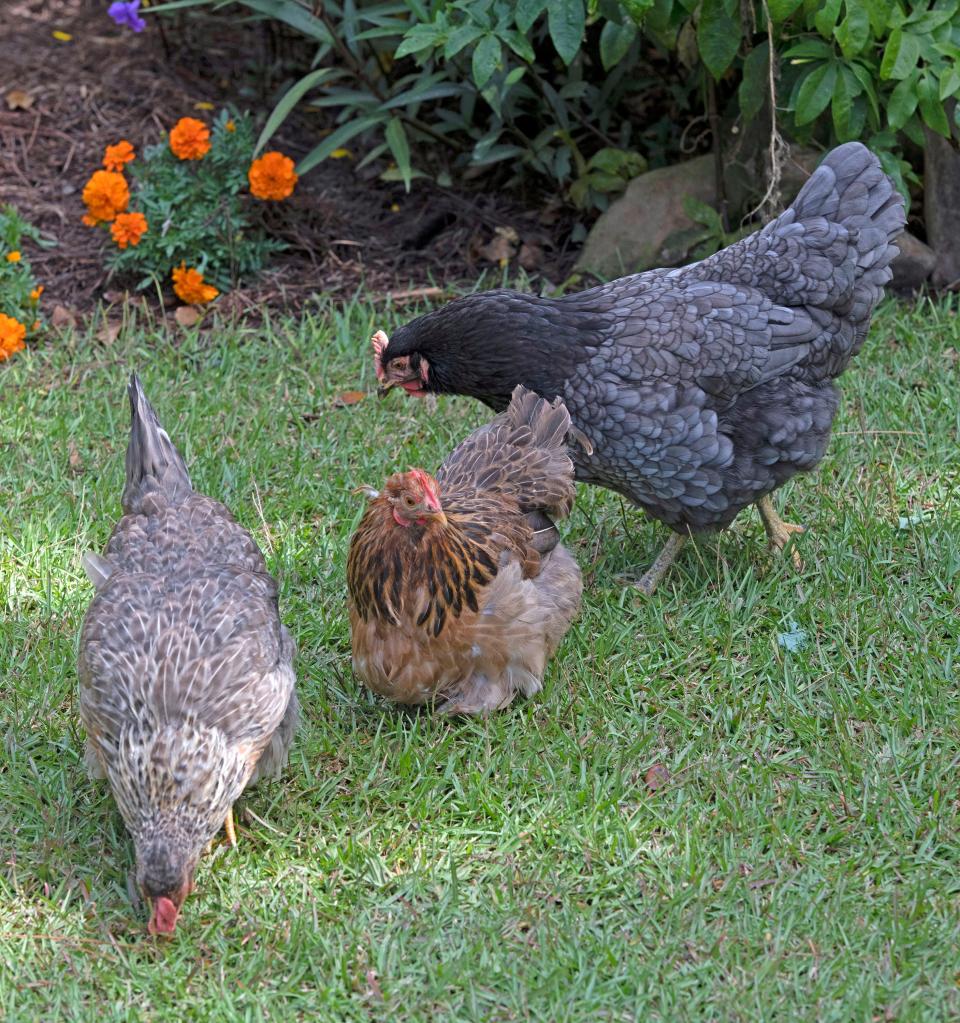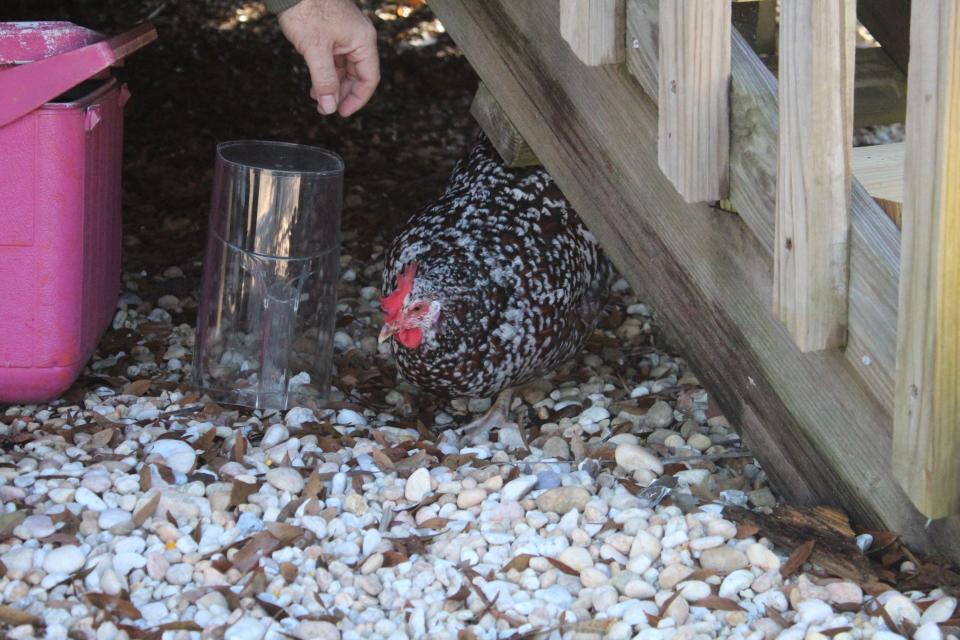Do egg prices have you considering a backyard chicken flock? Here's what you should know:
Walking into the store to pick up a dozen eggs has become an expensive endeavor for many families.
Overall food-at-home prices increased 11.4% in 2022, according to the consumer price index, a measure of the average change of prices over time.
But the cost of eggs was among the biggest leaps, with prices in 2022 jumping up 60%, according to the consumer price index.
The latest price influx of eggs has led some consumers to wonder, “Would it be cheaper to just raise my own chickens?”
Here’s what you need to know before deciding you want to raise your own backyard flock.

Egg alternatives:What you can use instead of eggs in cooking and baking amid soaring prices
Pensacola and Escambia County chicken ordinances
Before you do anything, you need to learn what city and county ordinances will allow you to do.
The good news is that you can have chickens in both areas.
In 2012, the Pensacola City Council amended the ordinances to update what is allowed and what is prohibited.
Here are some highlights:
You can have up to eight chickens on your property.
You can have free-ranging chickens on your property.
They must be setback 30 feet from adjacent dwellings, churches, hospitals, schools, public buildings and parks.
Roosters are prohibited.
For-sale poultry is prohibited unless zoning allows it.
Slaughtering poultry is prohibited.

Escambia County chicken ordinances are a bit looser. The Board of County Commissioners amended part of the Land Development Code by adding possession of live chickens as a permitted accessory for single-family residential dwellings.
That means that, notwithstanding any prohibition of farm animals or minimum lot area established for farm animals, you are allowed to raise chickens in all zoning districts except for Pensacola Beach and Perdido Key where single-family residential dwellings are permitted primary uses.
Here are the rules you must follow:
The owner or occupant of a lot that is a quarter acre or smaller may not own more than eight chickens.
Roosters are only permitted if kept no less than 100 yards from any inhabited residential dwelling other than the dwelling of the owner.
Chickens may roam freely in the fenced backyard of a single lot between sunrise and sunset. Overnight, they must be kept in secured coops, pens or enclosures to protect them from predators.
All pens, coops and enclosures must be a minimum of 10 feet from the rear and side property line of a single lot, and 20 feet from any residential dwelling on an adjacent lot.
Chickens can’t be kept for commercial purposes unless zoning allows.
Ready to get started? Here are the basics.
Now that you’ve found out you can actually own a chicken, where do you start?
Increased interest in backyard chicken production has improved the availability of chicks at many feed stores and rural suppliers, particularly in the spring, according to the University of Florida's Institute of Food and Agricultural Sciences Extension. Chicks may also be ordered directly from national hatcheries.
Newly hatched chicks need a heat source the first few weeks of life. The most common way to brood a small flock (25–50 chicks) is with a heat lamp.
Chickens are typically housed in a coup, pen or enclosure.
Getting a pen is easier than it sounds. You can get kits that come with everything you need to build one yourself, buy pre-assembled coups available at local feed stores or build your own.
The University of Florida Institute of Food and Agricultural Sciences recommends that the house size should be based on a minimum of 3 square feet of floor space per bird.

Protect your chickens from predators
Believe it or not, not even East Hill is safe for chickens to roam free.
According to 4-H Livestock Agent Aly Schortinghouse, predators are one of the more common issues people aren't prepared to face.
"So that could be anything from a hawk, or a cat, or a dog or anything found out in subdivisions," Schortinghouse said. "There's a lot of predators for chickens."
The best way to keep birds protected is to make sure they have enclosures with roofs to protect chickens from aerial predators and chicken wire to prevent outside animals from getting into the coop.
Egg-scuse me?Here's why egg prices are soaring across the US
Fact check:Social media post inflates egg price increases, omits other reasons for prices
Consider the cost of feed
Factoring the cost of feed is important, as feed accounts for about 70% of the cost associated with raising chickens, according to the UF/IFAS.
Chickens can forage for some of their nutritional needs, but access to highly nutritional foods will not only keep the chickens healthy, it will ensure optimal growth and development.
Feed comes in three different forms: Mash, crumble and pellets. These forms come down to personal preference as the nutritional value of each is the same, according to UF/IFAS Extension.
Using the right type of feed is also crucial, as growing chickens and laying hens will need to go through a variety of dietary transitions throughout their lives.
Here is a quick rundown of what UF/IFAS Extension recommends:
0-6 weeks: Chicks will require a starter feed that consists of between 20-24% protein. Expect to use at least four pounds of starter feed per bird.
6-18 weeks: Switch to grower feeder, which consists of between 14-16% protein. Male chicks will use grower feed indefinitely and don’t need layer feed.
18 weeks and older: Switch female chickens to layer feed to prepare them for egg production. This is between 14-16% protein and contains about 3.5-4% calcium.
How many eggs to expect
According to UF/IFAS Extension, most hens tend to produce about 200-240 eggs every year, or about 17-20 dozen. Egg production depends on several factors, such as breed, age, health, day length and more.
Roosters are male chickens and are not required in order for female chickens — hens — to lay eggs. When mature, the hen will lay eggs as a regular reproductive function of the body. Roosters are required, however, for fertilized eggs that will later hatch into chicks.
As the hens reach the age of 18–20 weeks, nesting boxes should be in place. Boxes that measure 12 x 12 x 12 inches and are half-filled with straw or wood shavings are ideal. Provide at least one nest box for every five hens in the flock, and place them about 2 feet above the ground.
Production decreases with shorter day lengths, so the UF/IFAS Extension suggests adding a clamping light source with a timer to provide birds with 14 to 16 hours of light.
Nesting boxes should be checked at least once a day for eggs. Eggs should not be allowed to accumulate in the nests. Otherwise, the hens will go out of egg production and want to sit on the eggs to incubate them.
This article originally appeared on Pensacola News Journal: Raising chickens in Pensacola: What you should know

